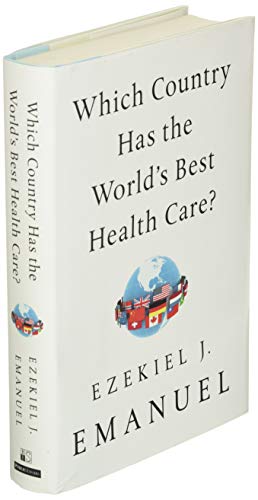




WHICH COUNTRY HAS THE BEST HEALTH CARE I
S**N
Good read for general intro to high-income countries' health care systems
Written by an eminent American scholar with extraordinary policy experience, this book offers a good overall summary of how several high-income countries organize, financing, and manage their health care systems. The book is good but not without flaws. Experts from specific countries will pick up on minor errors or misrepresentations here and there. And the structure of the chapters is a bit formulaic, resulting in some repetition within country descriptions. All of that said, the book is more approachable than comparative reports written more specifically for experts in health care policy.
D**Y
Glad I Read this book
As a Canadian who has travelled a lot of the world and in pre-Covid days spent winters in Hilton Head SC, I have got tired of defending the Canadian Health Care System with Americans. I believe that this book gives a clear and honest assessment of the health care management systems in both countries as well as several other countries. Not to say one is better than the other but rather I can now say they both are equally imperfect!
R**F
Useful Information, clearly Presented
The book: Which Country Has the World’s Best Health Care?, (Public Affairs, Hachette Book Group, 2020, 453 pp.)The author: Ezekiel J. Emanuel, M.D.Who is? Vice President for Global Initiatives and Co-Director of the Healthcare Transformation Institute, University of Pennsylvania (and winner of the Dan David Prize for medical ethics in 2019). Author or editor of 14 books and over 300 articles; the publisher asserts Dr. Emanuel is “the world’s most cited bioethicist.”Book’s Bottom Line: No country has the world’s “best" health care, but some are clearly better than others in providing health care to their citizens.How does he know? Because he did the research.Like what? Emanuel and his team of researchers studied in detail the health care systems of eleven countries, two in North America, six in Europe, and three in the Far East. The countries were, respectively, United States, Canada, United Kingdom, Norway, France, Germany, Netherlands, Switzerland, Australia, Taiwan, and China. These countries were selected because they vary in financing and delivery of health care, they are often cited in debates in the U.S. over comparisons with American care, and the countries can make plausible claims to being ideal in one or more health care delivery ways.One chapter is devoted to each of the eleven countries. Each country is assessed on the same eight “topics” (which include 22 “dimensions”):1. History of the health care system (how it got to where it is now).2. The extent of the country’s population served and the range of services provided.3. How the system is financed.4. What patients are expected to pay ‘out-of-pocket’5. How health care services are delivered (i.e., what subgroups are served, who are the providers, and where do they provide services)6. What human resources the system has to meet demands for the services promised and provided7. How prescription drugs and their prices are regulated by the system8. What challenges the system faces in the future if it is to continue to provide what is promised and intended.Some challenges are “universal,” while others may be specific to a given system. Universal challenges to all systems include:1. Increasing cost pressure of services, and cost containment in providing all the services promised by the system.2. The increasing cost of pharmaceuticals3. Reducing inefficiency in provision of care and eliminating unnecessary care.4. Coordination of care for patients with chronic illnesses and, similarly,5. Reducing the mismatch between health care delivery institutions and the needs of patients with chronic illnesses6. How to finance long-term care services7. The provision of adequate mental health services, in part to reduce the cost of other health services used.All the above are discussed at length in the chapters for each country, and in a final comparison chapter, where the countries are summarized in text and tables.What does Emanuel conclude regarding the United States, based on his research?The United States spends ~18% of its GDP on healthcare ($10,700 per capita), far ahead of second highest Switzerland (~12%, $9,700 per capita) but underperforms the other ten countries on most of the 22 dimensions in the book—sometimes by a great deal. It ranks near the bottom overall, just above China (so much for international Superpowers).So, are we doomed? No, says Emanuel.Although it is not feasible to “lift and shift” a health care system from some other country and just plunk it down in the USA, the author lists six “lessons” from his research on the eleven countries that can help the United States provide a health care system that better meets the needs of Americans and allows all of us to take genuine pride in our health care system. The implementation of each lesson is discussed in practical detail in the book, along with a justification for its inclusion among the six; I merely list the lesson headings below.Lesson 1: Ensure universal coverage via auto-enrollment and larger subsidies.Lesson 2: Cover children at no additional cost to parents and families.Lesson 3: Reduce the current complexity of the system.Lesson 4: Emphasize and increase the reimbursement for primary care.Lesson 5: Adopt and implement best practices for the care of patients with chronic and mental health conditions.Lesson 6: Join other countries in coordinated regulation of drug prices.Experts, and readers of the book, may have other “lessons” they believe offer better opportunities to improve the health of Americans, but—after reading the book—I found it difficult to dismiss any on Emanuel's list. Whatever the case, improvement is needed and it is possible. The alternative of continuing “as is” is financially untenable, continues the downward spiral of the health of significant numbers of American citizens, and jeopardizes the future of the United States as a respected—and respectable—member of the nations of the world.We can do this.
N**N
Disappointing
I looked forward to this book, but was underwhelmed by it. The individual chapters on each country were tediously written, almost just a recitation of the facts of each system. It needed more real life examples of how the systems affect the live of patients living under them. This did not come until the last chapter, which is the best part of the book. Comparing different facets of healthcare, such as long term care, innovation, drug coverage, etc. between the systems for more of the book would have been much more engaging
M**E
Ignores Sick Families going Broke from bills
As I read the introduction and reference to T.R. Reid 2009 investigative reporter, who is “Sick Around the World” asked a simple question “ How many people go Bankrupt aka Financial Stress in your Country (France, Germany, Switzerland, UK, Taiwan, Japan), the answer was “Nobody” one replied “It would be a National Scandal”. This author “poo poos” Going broke like 600,000 families do every year that puts stress on every family member. The USA is the only country in the World that permits families going Broke that takes May take decades to financially recover. Lots of topics to “Deflect” from the Scandal of going Broke from being Sick. The book could have been written by the CEO’s of Healthcare Insurance.
Trustpilot
2 weeks ago
1 week ago